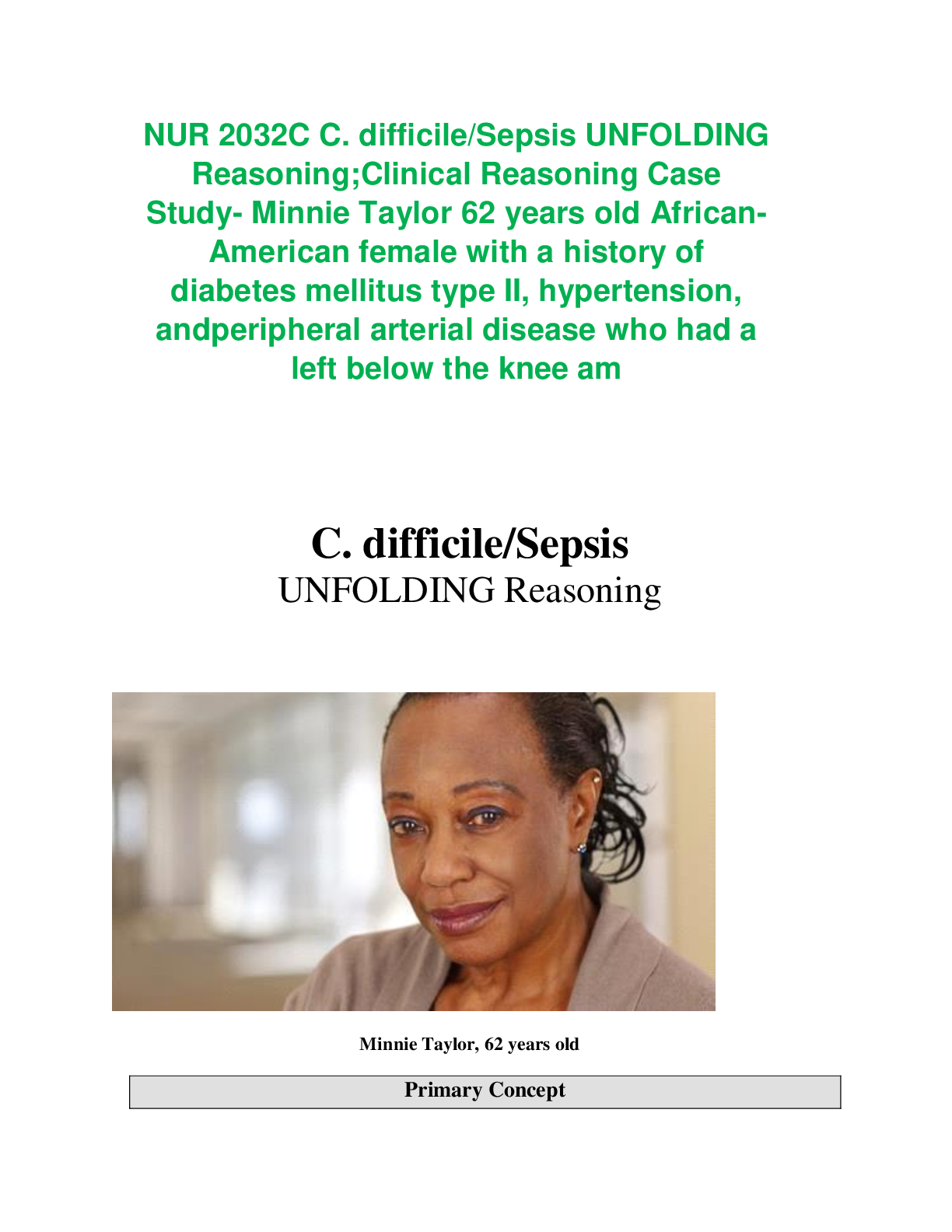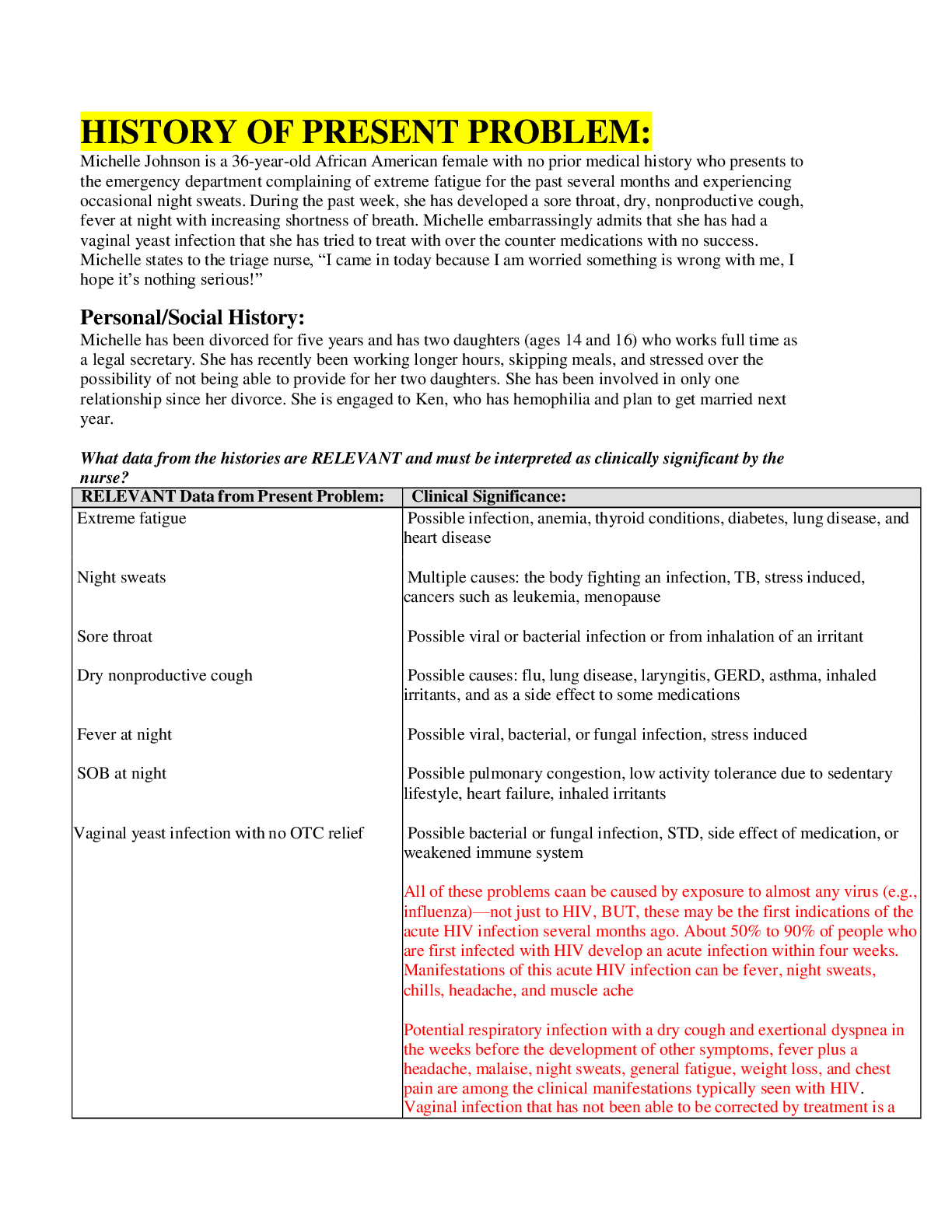*NURSING > CASE STUDY > FUN 1022 (FUN1022Fundamentals of Nursing ) (FUN 1022 (FUN1022Fundamentals of Nursing )) Pediatric As (All)
FUN 1022 (FUN1022Fundamentals of Nursing ) (FUN 1022 (FUN1022Fundamentals of Nursing )) Pediatric Asthma History of Present Problem: Jared Johnson is a 10 year-old African-American boy with a history of moderate persistent asthma.(complete answered
Document Content and Description Below
Pediatric Asthma FUNDAMENTAL Reasoning Jared Johnson, 10 years old Primary Concept Gas Exchange Interrelated Concepts (In order of emphasis) 1. Inflammation 2. Clinical Judgment 3. Patient Education �... � 2016 Keith Rischer/ FUNDAMENTAL Reasoning: STUDENT Pediatric Asthma History of Present Problem: Jared Johnson is a 10 year-old African-American boy with a history of moderate persistent asthma. He is being admitted to the pediatric unit of the hospital from the walk-in clinic with an acute asthma exacerbation. Jared started complaining of increased chest tightness and shortness of breath one day prior to admission. He has been at 50 percent of his personal best measurement for his peak expiratory flow (PEF) meter reading which did not improve with the use of albuterol metered dose inhaler (MDI) (per his written asthma management plan). In the walk-in clinic Jared is alert, speaking in short sentences due to breathlessness at rest. He has coarse expiratory wheezes throughout both lung fields with decreased breath sounds at the right base. His oxygen saturation on room air is 90%. His color is ashen and he has dark circles under his eyes. He is sitting upright and using his accessory chest muscles to breath and has moderate intercostal and substernal retractions. He is complaining of tightness in his chest. Jared was diagnosed with asthma at age 6 years and has three prior hospitalizations for asthma with one admission to the pediatric intensive care unit. He has never had to be intubated with these episodes. Personal/Social History: He is accompanied by his mother and 16-year-old sister. Jared lives with his mother, maternal grandmother, and sister in an older housing development in the inner city. He is in the 5th grade and a good student despite two to three absences per school year for his asthma. He likes to ride his bike and is the goalie on the soccer team. He says that he has lots of friends at school and likes his teacher, Mr. Bates, who is also his soccer coach. Both Jared and his mother deny tobacco smoke at home. What data from the histories are important and RELEVANT; therefore it has clinical significance to the nurse? RELEVANT Data from Present Problem: Clinical Significance: Acute asthma exacerbation, SOB, 50% PEF, wheezes, O2 sat: 90%, Dark circles under eyes, accessory chest muscle use, chest tightness. Hypoxic, increased respiratory effort. Asthma is a prevalent chronic condition in african american children. Poor Sleep quality RELEVANT Data from Social History: Clinical Significance: Absences from school, Lives in low income housing. Enviornment not conducive for an asthmatic child Patient Care Begins: Current VS: T: 99.9 F/37.7 C (oral) P: 120 (regular) R: 30 (regular) BP: 114/78 O2 sat: 90% on room air End Tidal CO2: 30 P-Q-R-S-T Pain Assessment (5th VS): Provoking/Palliative: Worsens when tries to take a deep breath. Feels better when Quality: Region/Radiation: Severity: Timing: © 2016 Keith Rischer/ allowed to sit upright on gurney Tightness Across anterior chest 8/10 Constant What VS data are RELEVANT and must be recognized as clinically significant to the nurse? RELEVANT VS Data: Clinical Significance: Pulse, Respirations, O2 Sat, Pain 8/10, End Tidal Patient is having anxiety due to asthma episode in addition to chest pain/ tightness. Tidal displays overexertion from breathing. Current Assessment: GENERAL Ashen, anxious appearing, moderate respiratory distress. Sitting upright on gurney. APPEARANCE: Only able to talk in short sentences due to breathlessness. Has intercostal and substernal retractions with increased respiratory rate, using accessory muscles to breathe (sternocleidomastoid muscles). RESP: Breath sounds with inspiratory and expiratory wheezing and prolonged expiration. Has tight-sounding non-productive cough, decreased breath sounds in right base CARDIAC: Pale, warm & moist at forehead, no edema, heart sounds regular with no abnormal beats, pulses strong, equal with palpation at radial/pedal/post-tibial landmarks NEURO: Alert & oriented to person, place, time, and situation (x4) GI: Abdomen soft/non-tender, bowel sounds audible per auscultation in all four quadrants GU: Voiding without difficulty, urine clear/yellow SKIN: Skin integrity intact, moist on forehead What assessment data are RELEVANT and must be recognized as clinically significant to the nurse? RELEVANT Assessment Data: Clinical Significance: Respiratory, Cardiac, General Appearance Displaying signs of respiratory distress and anxiety. Developing Nurse Thinking through APPLICATION of the Sciences Fluid & Electrolytes/Lab/diagnostic Results: Complete Blood Count: WBC (4.5–11.0 mm 3) Neutrophil % (42–72) Hgb (12–16 g/dL) Platelets (150-450 x103/µl) Current: 10.0 55 14.1 350 High/Low/WNL? WNL WNL WNL WNL What lab results are RELEVANT and must be recognized as clinically significant by the nurse? RELEVANT Lab(s): Clinical Significance: All Labs relevant CBC reveals no signs of infection or anemia © 2016 Keith Rischer/ Basic Metabolic Panel: Sodium (135–145 mEq/L) Potassium (3.5–5.0 mEq/L) Glucose (70–110 mg/dL) Creatinine (0.6–1.2 mg/dL) Current: 138 3.7 80 0.6 High/Low/WNL? WNL WNL WNL WNL What lab results are RELEVANT and must be recognized as clinically significant by the nurse? RELEVANT Lab(s): All labs relevant Clinical Significance: No signs of hypo/hypernatremia. No signs of hypo/hyperkalemia. No signs of hypo/hyperglycemia. No signs of acute kidney injury. Lab Planning: Creating a Plan of Care with a PRIORITY Lab: Lab: End tidal CO2 Normal Value: 35-45 Clinical Significance: Patient retaining CO2 Nursing Assessments/Interventions Required: Provide supplemental oxygen, High fowlers position and continue to monitor. Value: 30 mmHg Pharmacology: Home Med: Classification: Mechanism of Action: Nursing Considerations: Fluticasone/Sal meterol DPI 100 mcg/50 mcg 1 inhalation bid Corticosteroi ds Anti-inflammatory Caution in diabetes and glaucoma Albuterol HFA (hydrofluoroalk ane) inhaler 2 puffs every 4-6 hours as needed for symptoms Montelukast 5 mg every evening at bedtime Bronchodilat or Relax smooth muscle in airways Caution in cardiac diseases Leukotrene Antagonist Antagonizes leukotrenes resulting in decreased severity of asthma attacks Caution in hepatic impairment © 2016 Keith Rischer/ Pathophysiology: 1. What is the primary problem your patient is most likely presenting? Asthma 2. What is the underlying cause/pathophysiology of this primary problem? (Relate initial manifestations to the pathophysiology of the primary problem) Pathophysiology of Primary Problem: Rationale for Manifestations: common pumlonary condition defined by chronic Chest tightness, Sob, Wheezing inflammation of respiratory tubes , tightening of respiratory smooth muscle, and episodes of bronchoconstriction. Developing Nurse Thinking by Identifying Clinical RELATIONSHIPS 1. What is the RELATIONSHIP of the past medical history and current medications? (Which medication treats which condition? Draw lines to connect) Past Medical History(PMH): Home Meds: Moderate persistent asthma Fluticasone/Salmeterol DPI 100 mcg/50 mcg 1 inhalation bid Albuterol HFA (hydrofluoroalkane) inhaler 2 puffs every 4-6 hours as needed for symptoms Montelukast 5 mg every evening at bedtime Is there a RELATIONSHIP between any disease in PMH that may have contributed to the development of the current problem? (Which disease likely developed FIRST then began a “domino effect”?) PMH: What Came FIRST: Moderate persistent asthma What Then Followed: 2. 3. What is the RELATIONSHIP between the primary care provider’s orders and primary problem? Care Provider Orders: How it Will Resolve Primary Problem/Nursing Priority: Vital signs every 1 hour and as needed Assess respiratory status Continuous oxygen saturation monitoring Assess respiratory status Continuous end tidal CO2 monitoring Assess CO2 levels Start peripheral IV then saline lock Medication administration Assist in breathing and gas exchange O2 to keep saturations >93% Albuterol 2.5 mg and ipratropium © 2016 Keith Rischer/ To dilate bronchioles to increase breathing bromide 0.25 mg via face mask nebulizer every 20 minutes as needed for respiratory distress Methylprednisolone IV loading dose 2mg/kg then start Methylprednisolone IV 0.5 mg/kg every 6 hours for 48 hours Dilate bronchioles to increase breathing To decrease inflammation in the airway Diet as tolerated Developing Nurse Thinking by Identifying Clinical PRIORITIES 1. Which Orders Do You Implement First and Why? Care Provider Orders: Order of Priority: Oxygen via nasal cannula Oxygen, Inhalation to keep O2 sat at =/> 93% treatments, Establish and place on continuous IV, Obtain Vitals, CO2, O2 saturation monitor Rationale: The patients breathing takes priority over all other orders. Obtain vital signs (VS) every hour Albuterol 2.5 mg and ipratropium bromide 0.5 mg inhalation treatments every 20 minutes End tidal CO2 monitoring Establish peripheral IV and give first dose of methylprednisolone 2. What nursing priority(ies) will guide your plan of care? (if more than one-list in order of PRIORITY) 3. What interventions will you initiate based on this priority? Nursing Interventions: Rationale: © 2016 Keith Rischer/ Expected Outcome: 4. What are the PRIORITY psychosocial needs that this patient and/or family likely have that will need to be addressed? Patient is anxious and cannot breathe 5. How can the nurse address these psychosocial needs? Eduate the child on asthma and how to treat it 6. What educational/discharge PRIORITIES will be needed to develop a teaching plan for this patient and/or family? Medication education Caring & the “Art” of Nursing 1. What is the patient likely experiencing/feeling right now in this situation? Anxious and cannot breathe 2. What can I do to engage myself with this patient’s experience, and show that he/she matters to me as a person? Be present, Support the child and family. Use Reflection to THINK Like a Nurse Reflection-IN-action (Tanner, 2006) is the nurse’s ability to accurately interpret the patient’s response to an intervention in the moment as the events are unfolding to make a correct clinical judgment and transfer what is learned to improve nurse thinking and patient care in the future. 1. What did I learn from this scenario? Have students reflect and share How to treat an asthmatic pediatric patient 2. How can I use what has been learned from this scenario to improve patient care in the future? Have students reflect and share Ensure the use of inhalers in asthmatic patients © 2016 Keith Rischer/ . [Show More]
Last updated: 1 year ago
Preview 1 out of 9 pages
Instant download

Buy this document to get the full access instantly
Instant Download Access after purchase
Add to cartInstant download
Reviews( 0 )
Document information
Connected school, study & course
About the document
Uploaded On
Mar 04, 2021
Number of pages
9
Written in
Additional information
This document has been written for:
Uploaded
Mar 04, 2021
Downloads
0
Views
5



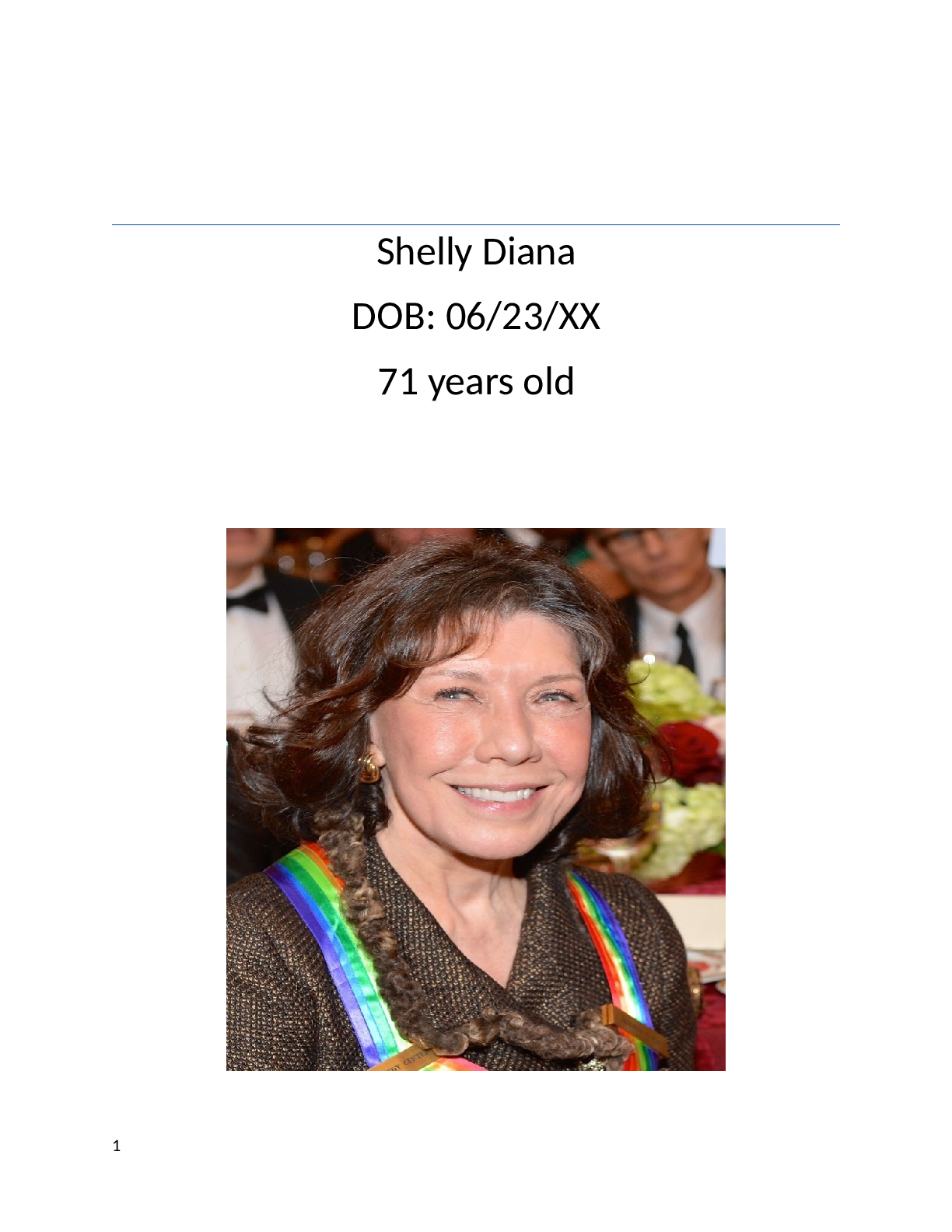
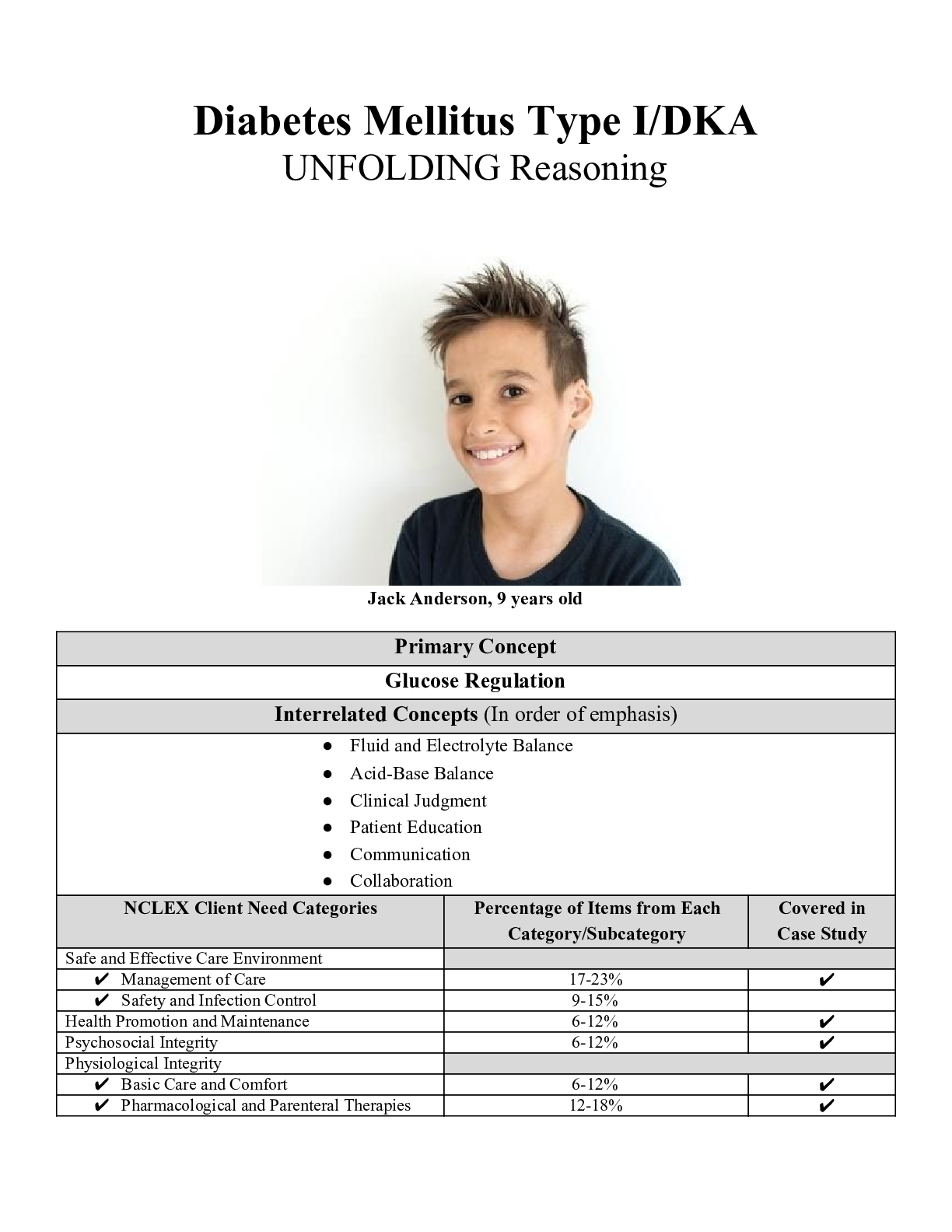

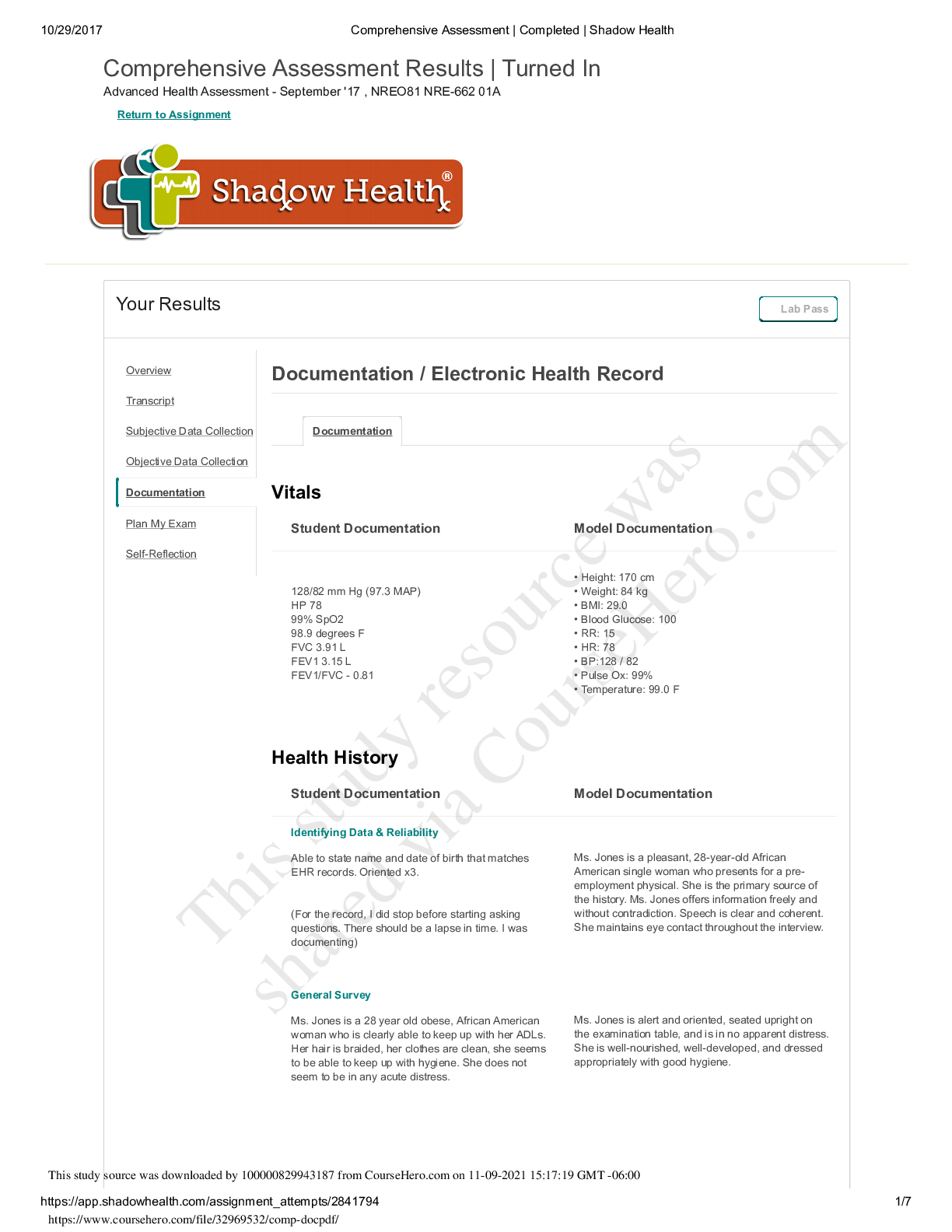

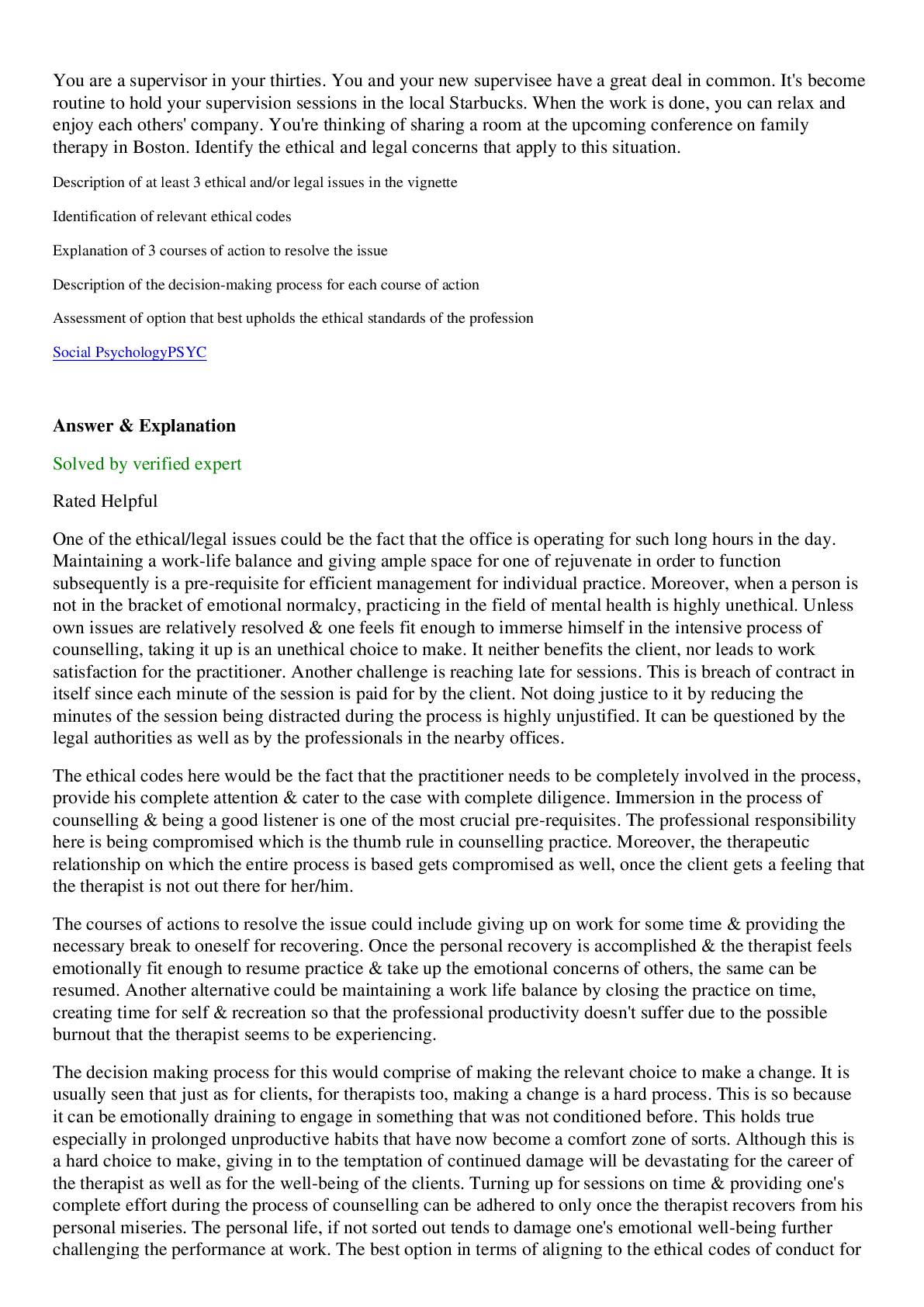
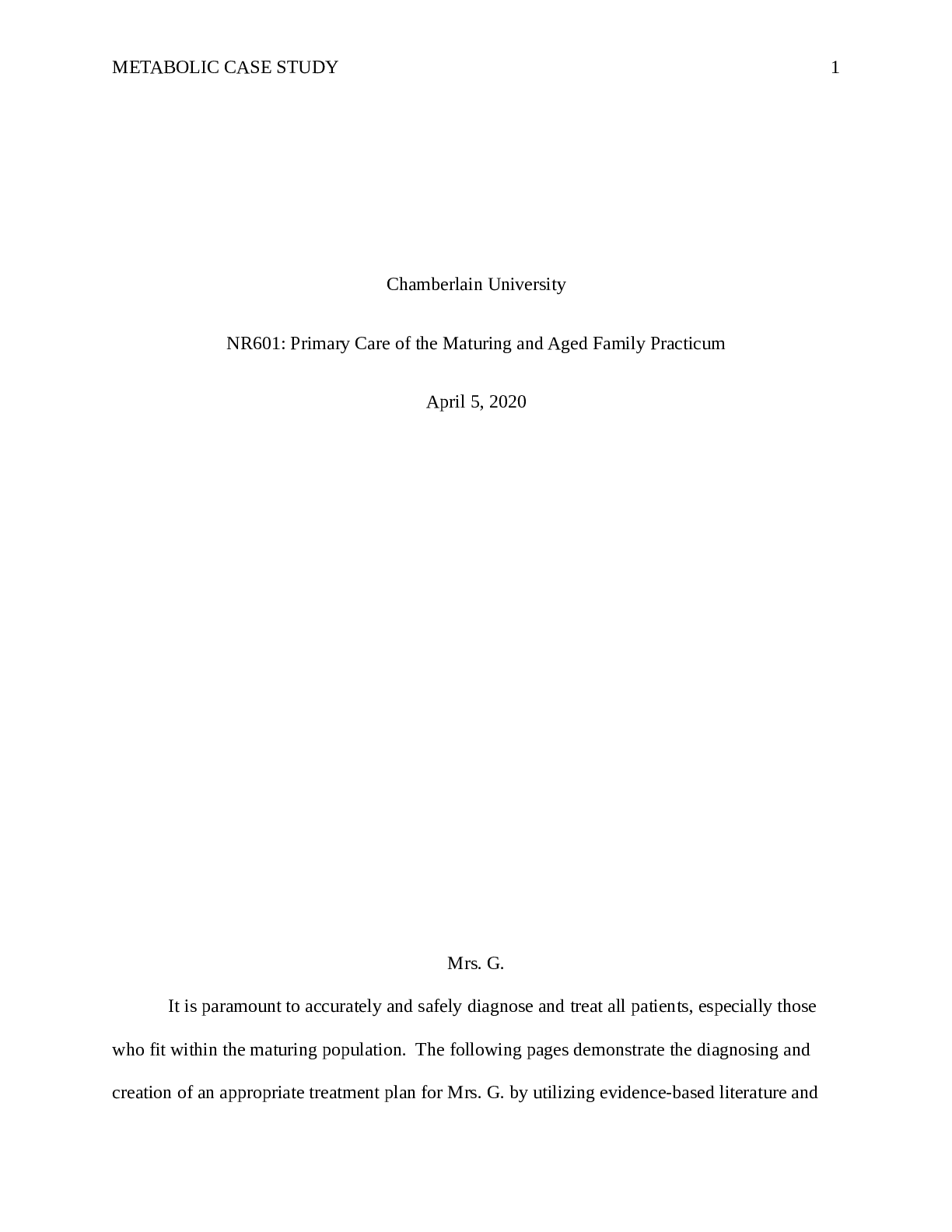

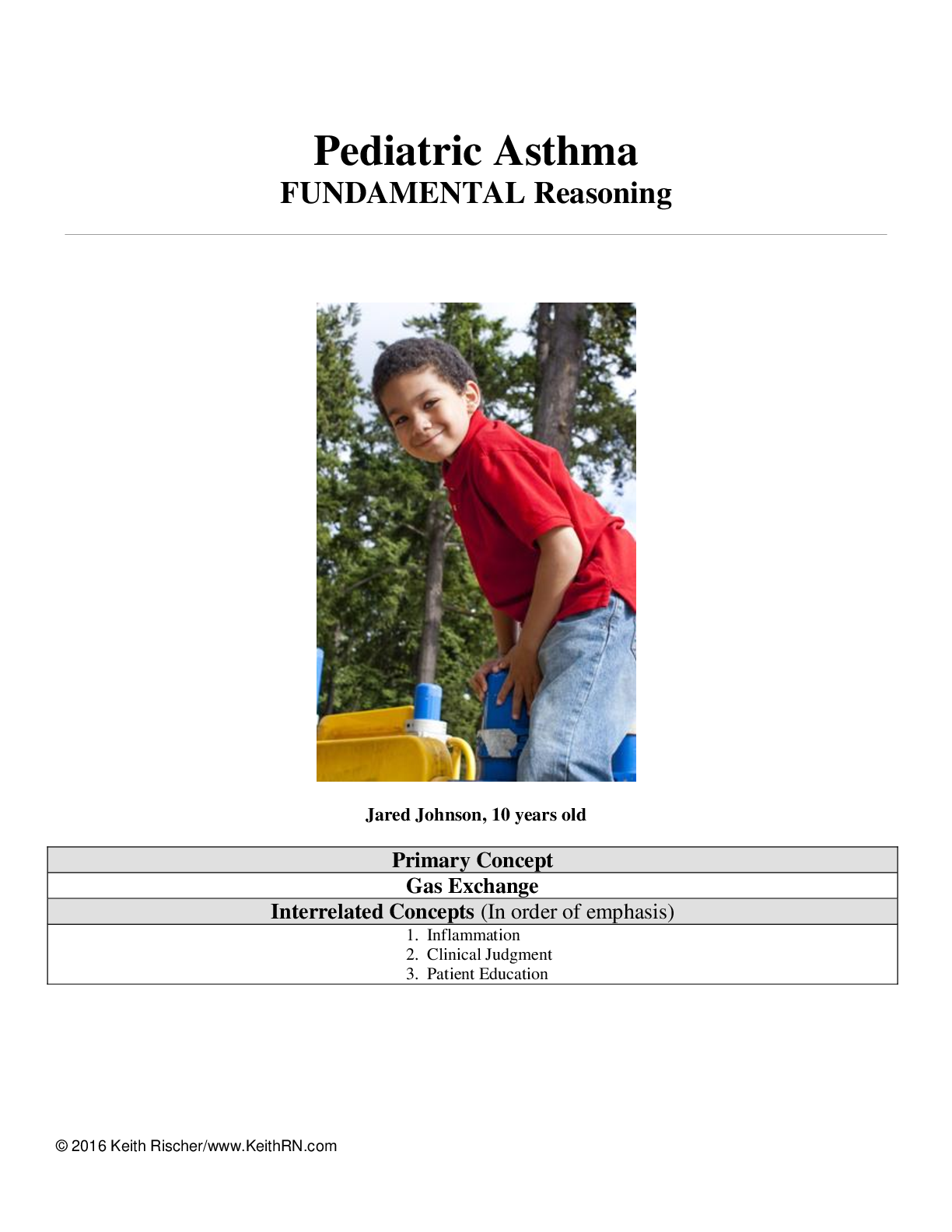
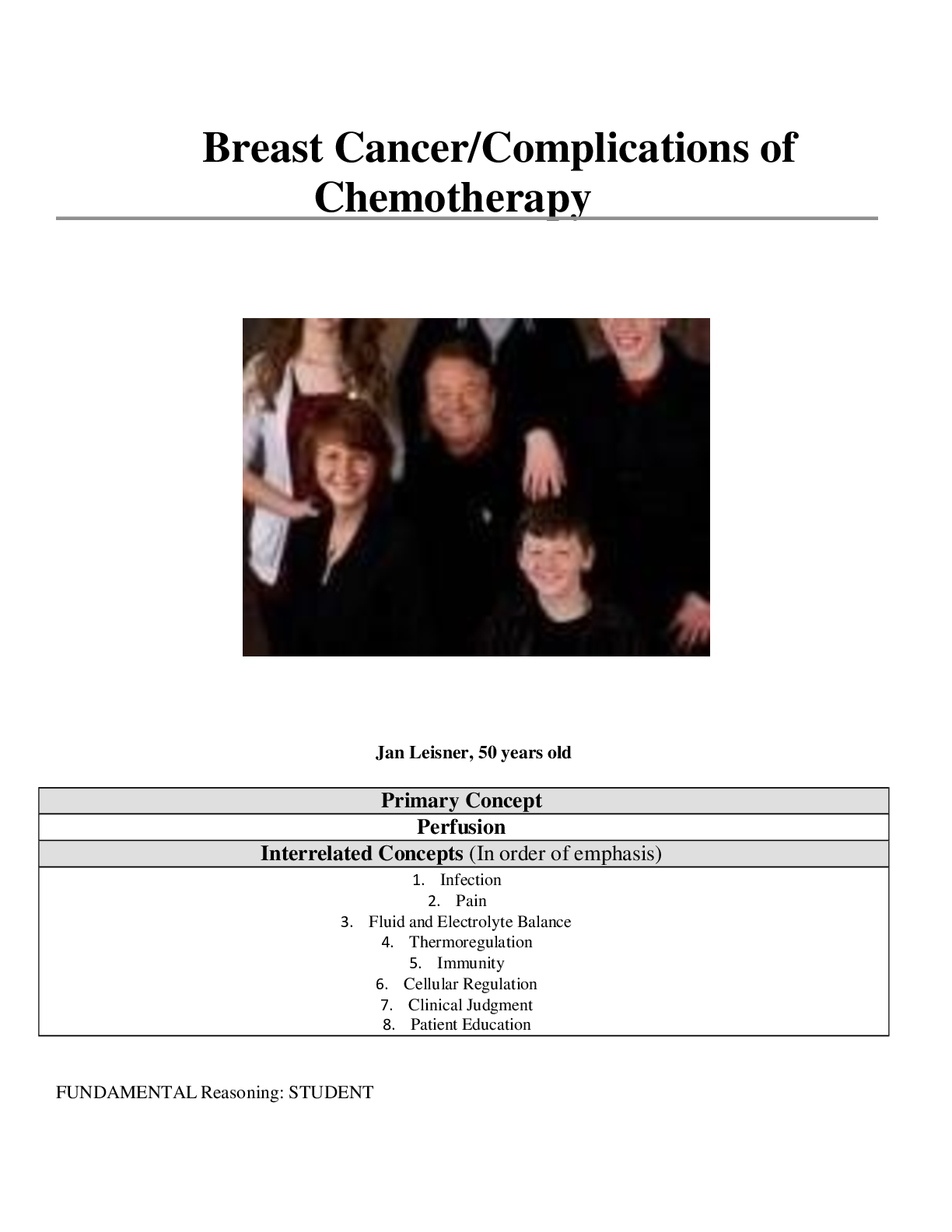


 COVID-19 Unfolding Case Study Part 1.png)

